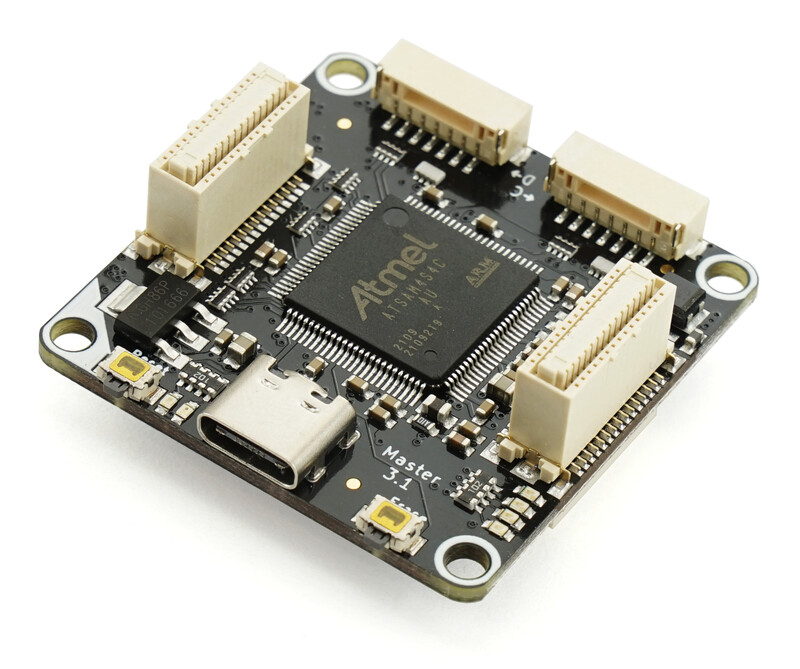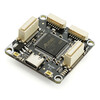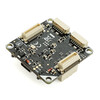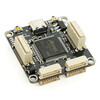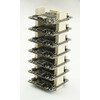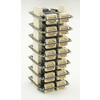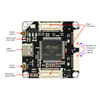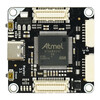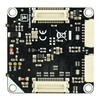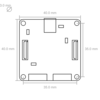Master Brick¶
Features¶
- Up to four 7-pole Bricklets usable over USB-C
- Is the basis to build stacks
- Usable with cable based and wireless Master Extensions
Description¶
The Master Brick can be used for two purposes: First of all it has four Bricklet ports (7-pole) and therefore is ideally suited for applications where a many Bricklets are used. These can be directly controlled over the USB-C interface of the Master Brick. This way USB sensors, like temperature or humidity sensors, or USB actors, like relays, can be created according to your individual needs.
Secondly, the Master Brick can be used for communication purposes. When building a stack the lowermost Master Brick acts as the master of the stack and routes all communication between the boards of the stack and the controlling device. Other Master Bricks in the stack detect that are not the lowermost Master and will only provide their attached Bricklets. This way only one USB connection, the one to the lowermost Master Brick, is necessary.
The USB connection of the Master Brick can be changed with Master Extensions. There are Master Extensions for cable based interfaces (RS485, Ethernet) or wireless interfaces (WIFI). Master Extensions have to be plugged on top of a Master Brick and will be detected as new interfaces. This way Bricks and Bricklets can be directly controlled from devices inside a network (WIFI or Ethernet) or can be interconnected over large distances (RS485).
The maximum stack consists of (bottom to top): 1x Step-Down Power Supply, 1x Master Brick or 1x RED Brick, 8x arbitrary Bricks (excluding RED Brick), 2x Master Extensions. With all Bricks being Master Bricks in a stack up to 9 Master Bricks x 4 Bricklets each = 36 Bricklets can be connected to a single stack.
The current Master Brick has hardware version 3.1. The differences to older version are described in the legacy section.
Technical Specifications¶
| Property | Value |
|---|---|
| Bricklet Ports | 4 |
| Dimensions (W x D x H) | 40 x 40 x 16mm (1.57 x 1.57 x 0.63") |
| Weight | 12g |
| Current Consumption | 410mW (82mA at 5V) |
Resources¶
Connectivity¶
The following picture depicts the different connection possibilities of the Master Brick.
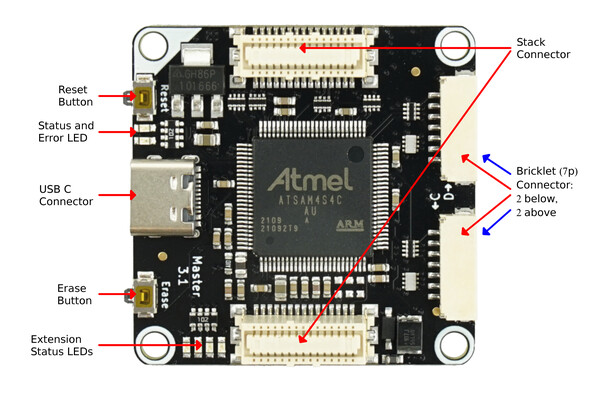
Test your Master Brick¶
To test a Master Brick you need to have Brick Daemon and Brick Viewer installed. Brick Daemon acts as a proxy between the USB interface of the Bricks and the API bindings. Brick Viewer connects to Brick Daemon. It helps to figure out basic information about the connected Bricks and Bricklets and allows to test them.
Now connect the Brick to the PC over USB, you should see a new tab named "Master Brick" in the Brick Viewer after a moment. Select this tab.

You should see that the Master Brick isn't measuring any stack voltages or currents. This is because you have not attached a Power Supply. When attaching such a board you should see the voltage applied to your stack and the current flowing in.
After this test you can go on with writing your own application. See the Programming Interface section for the API of the Master Brick and examples in different programming languages.
Legacy Master Bricks¶
The Master Brick 3.1 (current version) has USB-C and four 7-pole Bricklet connectors.
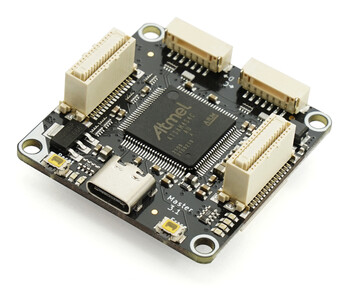
Master Bricks with hardware version 1.0, 1.1, 2.0 and 2.1 have Mini-USB and four 10-pole Bricklet connectors.
The old Master Bricks can be used together with legacy 10-pole Bricklets as (10p-10p Bricklet cable as well as new 7-pole Bricklets (7p-10 Bricklet cable). The new Master Brick is only compatible to 7-pole Bricklets (with a 7p-7p Bricklet cable).
Master Brick 2.1 is still available in our shop.
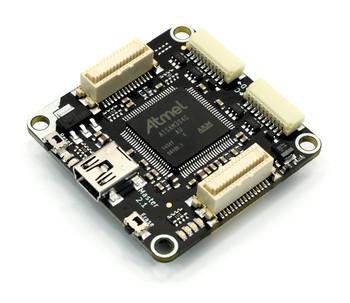
Errata Hardware Version 3.1¶
Embarrassingly we introduced a hardware bug in hardware version 3.1.
In hardware version 3.1 we mixed up two pins on the stack connector that are used with the RS485 Extension. This bug was introduced in a last-minute change that we did between version 3.0 and 3.1 (3.0 was just used internally and was never released). Because of this error the RS485 Extension does not work with the Master Brick 3.1.
This will be fixed in the soon to be released Master Brick 3.2.
Programming Interface¶
See Programming Interface for a detailed description.
| Language | API | Examples | Installation |
|---|---|---|---|
| C/C++ | API | Examples | Installation |
| C# | API | Examples | Installation |
| Delphi/Lazarus | API | Examples | Installation |
| Go | API | Examples | Installation |
| Java | API | Examples | Installation |
| JavaScript | API | Examples | Installation |
| LabVIEW | API | Examples | Installation |
| Mathematica | API | Examples | Installation |
| MATLAB/Octave | API | Examples | Installation |
| MQTT | API | Examples | Installation |
| openHAB | API | Examples | Installation |
| Perl | API | Examples | Installation |
| PHP | API | Examples | Installation |
| Python | API | Examples | Installation |
| Ruby | API | Examples | Installation |
| Rust | API | Examples | Installation |
| Shell | API | Examples | Installation |
| Visual Basic .NET | API | Examples | Installation |
| TCP/IP | API | ||
| Modbus | API |


